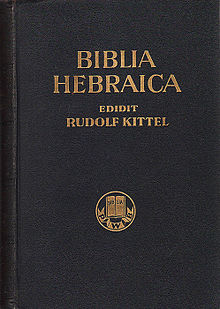Biblia Hebraica (smock)
| Biblia Hebraica series | |
|---|---|
|
BHK Biblia Hebraica Kittel (1st – 3rd) BHS Biblia Hebraica Stuttgartensia (4th) BHQ Biblia Hebraica Quinta (5th) |
|
| Ed. | Rudolf Kittel , Georg Beer , Paul Kahle , Albrecht Alt |
| language | Biblical Hebrew , Biblical Aramaic |
| Publish | BHK 1 : 1906, BHK 2 : 1913, BHK 3 : 1937 |
| Subsequent edition | Biblia Hebraica Stuttgartensia |
| Website | https://www.bibelwissenschaft.de/de/startseite/wissenschaftliche-bibelverbindungen/biblia-hebraica/bhk/ |
Under the name Biblia Hebraica (Kittel) , abbreviated BHK , a series of Rudolf Kittel u. a. Edited and text-critical editions of the Hebrew Bible that are important for research history .
First and second edition of the Kittel'schen Biblia Hebraica (BHK 1 and BHK 2 )
The first Biblia Hebraica (BHK 1 , sometimes BH 1 ) published by Rudolf Kittel appeared in 1906 at the JC Hinrichs publishing house in Leipzig. The basis of the text was the version of the Masoretic text published by Jacob ben Chajim in 1526 at Daniel Bomberg in Venice , the so-called Rabbinical Bible . The Masoretic text was reproduced with the vowel and accent marks , but without the marginal notes and further notes ( Masora Parva and Masora Magna ). Kittel added a critical apparatus with selected text variants from Masoretic manuscripts and ancient translations . The Samaritan Pentateuch , the Septuagint , the Vulgate and the Peshitta were used . The second edition (BHK 2 or BH 2 ) was still published by Hinrichs in 1913; from 1921 onwards it was reprinted by the Württembergische Bibelanstalt , which had taken over the rights. In 1925 a complete overhaul was started.
Third edition of the Biblia Hebraica Kittel (BHK 3 )
For the first time, the textus receptus of Jacob Ben Chayjim was no longer used as the basis for the text of the third edition of the Kittel Bible (BHK 3 , sometimes simply quoted as BHK or BH 3 ) , but the Codex Leningradensis ("Handwriting L") from 1008 , the oldest dated manuscript of the Masoretic text in the entire Hebrew Bible . Paul Kahle was instrumental in promoting their use . It was also Kahle who made sure that, in addition to the text, the Masoretic marginal notes ( Masora Parva ) in the form as they appeared in the manuscript were included in the printed edition. The BHK 3 is thus the first diplomatic text edition of a medieval Bible manuscript together with its Masora Parva. This was made possible by borrowing handwriting ЕВР B19 A Public Library Leningrad (hence "L" or "Leningrad" as a designation of the manuscript), today's Russian National Library in St. Petersburg , to the Old Testament Seminar of the University of Leipzig . The older (though not by a colophon (document) dated) and more accurate, also the time of printing yet complete Aleppo Codex could not be used because it was Kahle failed to persuade the owner to a photographic recording.
In addition to the text and the Masora Parva, BHK 3 contained two text-critical apparatuses , one for the "less important" and one for the "more important" variants. Rudolf Kittel, who died in 1929, did not see the completion of BHK 3 . During his lifetime, only two deliveries for Genesis and Isaiah (1929) for which he was responsible appeared. Albrecht Alt (Leipzig) and Otto Eißfeldt ( Halle ) followed Kittel as editor-in-chief. The appearance of the other deliveries lasted until 1937, when the deliveries for Daniel, Esra – Nehemia and the Chronicle appeared. The complete work could also appear in 1937, each time at the Württemberg Bible Institute in Stuttgart.
The Qumran scripts discovered since 1947 , which are about 1000 years older than the Codex Leningradensis and the Codex of Aleppo, led to the need for a revision of the Biblia Hebraica (Kittel). However, this processing of the Hebrew Bible was subject to difficult initial conditions, e. B. because the turmoil of the Second World War had lost the printing matrices , so that no more changes could be made to the text that had already been set. Since the 7th edition of the BHK in 1951, at least the text variants of two particularly important Qumran manuscripts for the books Isaiah (the variants from 1QJes a ) and Habakkuk (the variants from 1QpHab ) have been added as an additional apparatus at the bottom of each page.
Subsequent editions
The third edition (BHK) was replaced by the Biblia Hebraica Stuttgartensia . Until the full publication of its successor, this will remain the current scientific edition of the Codex Leningradensis, which includes all books of the Hebrew Bible. The current project in this tradition and under the umbrella of the same Bible Society is called Biblia Hebraica Quinta .
Bibliographical information
- BHK 1 : Biblia Hebraica, edited by Rudolf Kittel, Leipzig, Hinrichs, 1905/1906; Part I & Part II , 1905 , I 1909 , II 1909 .
- BHK 2 (editio altera): Biblia Hebraica, edited by Rudolf Kittel, Leipzig, Hinrichs, 1912; Digitization of a reprint by the Privileged Württemberg Biblical Institute without a year; the new publisher's name is glued to the title page.
- BHK 3 (editio tertia): Biblia Hebraica, edited by Rudolf Kittel, Paul Kahle, Albrecht Alt and Otto Eißfeldt, Privilegierte Württembergische Bibelanstalt, Stuttgart, 1937
Individual evidence
- ↑ Jacob ben Chajim (ed.): Torah Nevi ʾ im u-Khetuvim: yitbarekh ha-me ʾ ir me-ishon asher hetiv hasdo ha-aharon min ha-rishon ... rishonah ha-Humesh ʿ in the Targum u-ferush Rashi ve Ibn ' Ezra u-farfera ' ot mi-ba ' al ha-turim, ve-ha-Nevi ' in ha rishonim ' in Perush Rashi ve Kimhi ... Bomberg, Venice 1526 ( digitale-sammlungen.de ) .
- ↑ a b German Bible Society for the BHK
- ^ Paul Kahle, Foreword to BHK 3 , VI.
- ^ Rudolf Kittel, Foreword to BHK 3 , III.
- ↑ BHK 3 , imprint.

